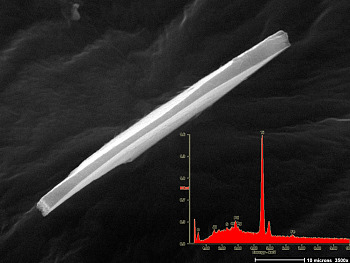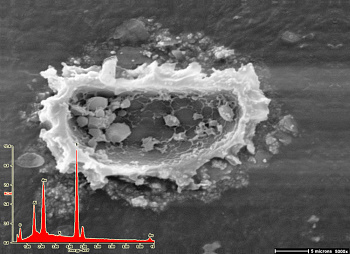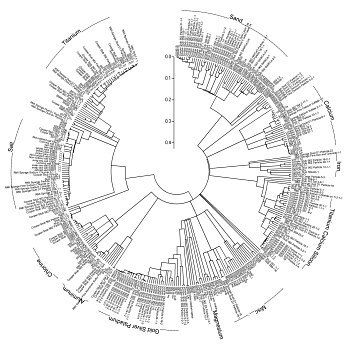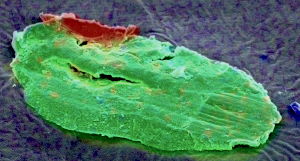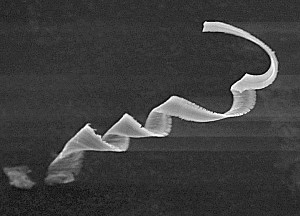|
Fact: Microscopic metallic titanium pieces were found on Cooper's tie. Fact: Spiral chips of aluminum and other exotic metals like bismuth and stainless steel were found on the tie. Fact: In 1971, only engineers and managers in fabrication plants wore ties to work. |
|
|
|
Introduction Of all the particles examined on the tie, the titanium particles were the most distinctive. In 1971 titanium was not in common public use the way it is today. Extensively used by the military in aircraft and helicopters, it was just making its way into commercial airliners. The Super Sonic Transport was designed mostly out of titanium which would have been a first for that era. The other area of titanium use was in chemical processing where titanium's resistance to corrosion by acids and caustics made it worth the high price. Notably, the chemical industry used pure titanium since it has the best corrosion resistance. Methods Sticky carbon tape on stubs were used to lift samples from the tie (Fig. 2) and Figure 3 shows a titanium particle known as the "bird bath" due to its concave shape. It With some particles elemental maps were recorded as in Figure 5. These maps color code the areas of particular elements and in this example, detected that there were two types of metal bound to each other in a single particle. The large particle in green has a spectrum that shows it is pure titanium metal, while the smaller attached particle in red is a form of stainless steel. From the striations in the metal, the two metals were interpreted as having been smeared into each other by external forces. The EDS analysis [1] determined the red particle was a 400 series stainless steel. A large number of elemental spectra of particles were recorded in the course of this research. In order to visualize the relationships, quantities and related families of particles, a custom software program was written to convert the spectra into a format that could be read by other programs. The MEGA (Molecular Evolutionary Genetics Analysis) was chosen to group the spectra into a family tree (Fig. 4). This software is normally used with DNA "bar code" to show relationships between groups related through DNA. The elemental spectrum is from a mathematical perspective, essentially the same thing, and will thus produce a family tree. The shorter the branch length between two particles, the more similar their elemental compositions. The tree shown in Figure 4, represents more than 450 spectra and are labeled according to their predominant groups. The rarity of titanium and the limited number of places that it could be found in 1971 made it a focal point in this investigation. The fact that military or commercial aircraft all use alloyed titanium exclusively, ruled them out since the particles found on Cooper's tie were pure titanium. The Super Sonic Transport made almost completely out of titanium, was canceled that year throwing the entire titanium industry into turmoil. There were large numbers of layoffs due to the cancellation, so it is still conceivable that Cooper may have in some way been affected by this slow down. Working upstream in the production process, the titanium sponge plants used sodium, chlorine and magnesium of which sodium and chlorine were prevalent on the tie. This sparked an extensive investigation into the companies involved and the production processes. Original samples of titanium sponge from the 1970's were obtained [2] for comparison. Titanium sponge particles have a distinctive appearance and the second sampling of the tie should have been thorough enough to produce sponge samples, but no identifiable sponge particles were found. It was finally determined that the titanium, chlorine and sodium signatures could be found in match heads. Match residue was found in abundance on the second sampling of the tie and this is consistent with the description of Cooper as a "chain smoker" [3]. The sands from which titanium is extracted were also never detected on the tie. This narrowed the potential field to pure titanium fabricators and companies that would have used anti-corrosive titanium. The information on these areas now becomes quite sparse. Oremet was a titanium sponge producer out of Portland that also produced pure titanium parts for chemical companies along with another Portland company Precision Cast Parts Corp. [4]. For proximity Ormet is a likely candidate but they used a magnesium process to produce titanium and only a couple of Mg particles were found on the tie. Anyone with information about these types of companies in the 1970's is encouraged to contact us. The titanium and stainless particle is quite informative (Fig. 5). This particle requires several Two spiral aluminum chips were extracted from the tie (Fig. 6). These spiral were very small at about 1/16" in length and were perfectly formed by a rotational cutting process like a lathe or Anecdotal, many particles of brass were also found on the sticky stubs and in the vacuum filters used to collect the particles. They are not included in this analysis because brass screw plugs were used to seal the sample filters. In order to rule out contamination, micro-x-ray fluorescence must be used to determine the exact type of brass for both the plugs and the particles, but these Conclusions Titanium was a rare metal in 1971 and this makes it extremely unlikely it is a post-event contamination. Its presence constrains Cooper to a limited number of managers or engineers in the titanium field that would wear ties to work. This is also consistent with his mannerisms during the hijacking where the flight attendants described him as an "executive" [6]. The fact that he was also comfortable enough to pull off the hijacking wearing a suit suggests that it was a regular part of his wardrobe, again consistent with a manager or engineer type. Given pure titanium with embedded stainless steel, spiral chips made from aluminum and other exotic metals, gives a "best fit" indication that Cooper came from or regularly visited a metal fabrication facility. These types of materials are known specifically for their corrosion resistance and commonly used in highly corrosive environments, such as chemical factories. A suspect having worked in a machine shop or a company that used pure titanium in a corrosive processes would be a good match to the family of particles found on Cooper's tie. References 1. EDS Quantification of elemental composition for the stainless particle embedded in titanium. Chromium 14.83%, iron 84.67%, nickel 0.49% all Wt% 2. Personal communication: Dr. Danny Eylon provided samples of titanium sponge from the 1970's originally from Reactive Metals Inc. (RMI) in Ohio. 3. FBI Transcripts, Mucklow: " In this connection, she also recalled that he was a chain smoker." 4. "Titanium: Past, Present and Future", Report of the Panel on Assessment of Titanium Availability: Current and Future Needs. pg. 178 5. "Evaluation of tensile properties of 5052 type aluminum-magnesium alloy at warm temperatures", Archives of Materials Science 6. FBI Transcripts, Mucklow: "The man impressed her as being an executive by his dress, special mannerisms, and consideration that he exhibited for her while he was on the aircraft" |
|
|
|
|
||
